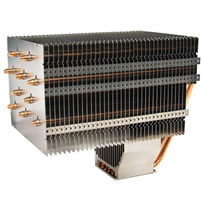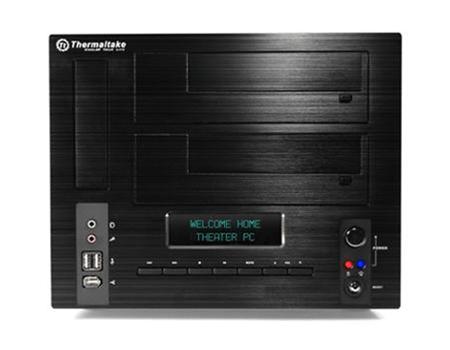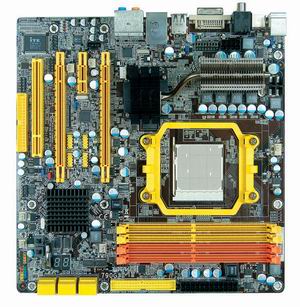Completely Solid State 64-bit Dual-Core Media Center PC
This is a project that I've been plotting for quite some time now, and I'm finally about the have a go! The idea is simple, I want to build a media center PC, but with some perhaps-slightly-unusual requirements - purely to suit my own preferences.
-
Completely Solid State - of course, that means absolutely no moving parts (except for a possible DVD-ROM drive that would sit idle most of the time). So no fans, no traditional hard disks, no liquid cooling, etc.
Just on the fanless bit, I understand (and mostly agree with) the belief that a very large, slow spinning fan is almost completely quiet, and is far better than no fan. However, experience has taught me that a quiet fan today, is a noisy fan next year! :( Admittedly, I've really only ever used cheap fans, so maybe that's the problem. Anyway, I'm going to try hard for fanless, but I'm will be somewhat content to settle for an ultra-quiet fan in the end... we shall see :)
-
At Least 720p Playback - naturally 1080p would be great, but the reality is, I'm likely to have a lot of new options available to me by the time I actually have any significant 1080p content available to me.
-
64bit Dual Core - this one really is a matter of personal preference. There's really no need for the SSMPC to be 64-bit, but it would just feel like a step back to build a 32-bit PC today ;)
And as for the dual-core... well, I really like the idea of have a spare core to help me recover the system when a single process goes rogue. It also means that the UI can remain responsive, even when processing high quality video.
-
Small and Good Looking - these are, of course, very relative terms. "Small" can mean many different things depending on the context, and in this case, I don't mean "really small" since that would probably be impossible given the fanless requirement. And, of course, good looking is largely a matter of taste.
Ok, so how am I going to do it? Well, obviously challenge is going to be the fanless bit. To achieve fanless PC operation, we need to do two things: 1. minimise the heat produced by the PC, and 2. maximise the natural air flow through the PC.
Minimising the heat production mostly comes down to parts choice, so here's the parts I've chosen so far:
-
CPU: AMD ADD3800IAA5CU - officially called an "AMD Athlon™ X2 Dual-Core", this is a very special dual-core CPU. Special, because even though it fits a standard AM2 socket, it TDP rating is a mere 35W. This is a low as you can currently get, without going to mobile processors (which would be good, but the price skyrockets!!). Note, theses are actually quite hard to get, so I was very happy when I managed to nab one from eBay :)

-
Hard Drives - none! Well, not the tradition kind anyway. Hard drive's do generate a substantial amount of heat and noise, so I was originally going to solve this problem by net-booting the SSMPC... but then I decided that it would be faster, and easier to manage, if it booted from a USB key. Of course, now I could use an SSD disk, but they're still too expensive for me. They are dropping in price quite quickly, so maybe in a year or so?
-
Power Supply - this is a tough one... very few PC power supplies can truly work fanlessly. There are few that claim to, but also state (usually in smaller print) that the require a chassis fan to make up for the lack of PSU fan, so that won't do. And power supplies themselves generate quite a bit of heat (hence their need to have fans).
I have considered building my own, completely external power supply with large air-cooled heatsinks... it would kind of look like a large amplifier, but that did seem a little over the top (although it would be a fun but of electronic engineering).
In the end, I've decided to use a picoPSU-120. This is great little power ATX power supply that only requires a single 12 volt supply. Thus, you can move the 240Vac-down-to-12Vdc part of the typical PC power supply to an external power adapter "brick". You can read an excellent review over at silentpcreview (an excellent site, by the way).
-
CPU Cooler - probably the hardest part to choose! Because the space in which I can put the SSMPC, I need to use a horizontally-mounted motherboard, and hence need a "top-down" styles cooler. And, of course, to get excellent passive cooling, I'm going to need a large a surface area as possible. Now there are a number of great CPU tower coolers out at the moment, but their all designed for tower chassis, thus if you mount them horizontally, there's no easy path for convection currents to flow. Of course, if they are fan-forced, then that's not an issue, but I really want to go completely fanless here!
So, after much debate, and pondering, I've settled on a CPU cooler that many think is ridiculous... the Scythe Orochi!! Now this thing is huge!!! And heavy. Many people rightly claim its too heavy for a tower, but as I mentioned a minute ago, I'm going to mount it horizontally. There, with its generous fin spacing, and vast radiating area, this thing should give me a better chance at passively cooling my dual-core processor than anything else currently on the market.

-
Chassis - finding a case that would fit in my media center's shelving, and allow any decent cooler at all, let a lone something as big as the Orochi was quite a challenge. The short list of possibilities it came down to a choice between the various Thermaltake Lanbox chassis, and the Silverstone SG-01 and SG-02 models. But in the end, I had to go with a Lanbox because their ventilation is vastly superior to the SG's, and the Lanbox (at least the one I chose) allows you to leave out a large number of part of the chassis' internals - which will be extremely handy when trying to use an Orochi! :)
Anyway, the case I chose was a Thermaltake LanBox HT.

-
Motherboard - it may seem strange that I left this part to last, but in the case if this MMSPC, the motherboard really is only the final piece. There are a number of great choices for socket AM2/AM2+ motherboards out there. But in the end, I chose the DFI LANParty JR 790GX-M2RS. As of this writing, it's the only micro-ATX motherboard with an AMD 790 series chipset. So I choose it mainly in an attempt to future-proof the SSMPC. It's probably a little bit of overkill, but then being a DFI LANParty, it has excellent voltage / over-clocking control - and with that, excellent under-volting and under-clocking control, which I may just need to achieve fanless operation...

So, where am I up to? Well, I have all of the parts now, except for the external 12v brick... it actually turns out to be reasonably hard to get one above 70 watts or so, but I've found one, and it's on it's way :)

